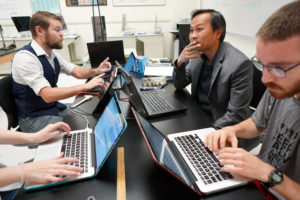UMW Professor of Physics Hai Nguyen knew the odds were against him. Thousands of scientists – the best of the best from across the country – vie each year for fewer than 150 first-time fellowships with the American Association for the Advancement of Science (AAAS).

He estimated his chances of being chosen at .0001 percent; then the phone rang. The scholar who’d solved equation after equation on the way to a Ph.D. and post-doctoral work in atomic physics had gotten one wrong.
In September, Nguyen left his office in Jepson for an AAAS fellowship in Washington, D.C., as a science advisor in the Office of the Secretary of Defense (OSD). Instead of for students, he’s breaking complex concepts into digestible information for politicians and top-level executives who influence lawmakers on Capitol Hill.
It’s a “brain-draining” yearlong experience, Nguyen said, but he sees it as a chance to serve his country – and UMW. The insight, perspective and hard-hitting contacts he brings back to campus will fuel the Physics for Future Presidents and World Leaders First-Year Seminar (FSEM) he helped create and set Mary Washington students up for success.
Born in Vietnam, Nguyen was 14 when he came to America with his parents and siblings. By the mid-1990s, he was the first in his family to make it to college, and he went full-throttle, devouring physics and math at Wisconsin’s Saint Norbert and earning a doctorate from Kansas State University (KSU). Well before coming to work at Mary Washington in 2010, he knew he wanted to teach the fundamentals of physics, but he hadn’t thought much about how they fit into national policy on issues like space travel, global positioning and nuclear weapons.
A dinner in D.C. to discuss an idea for a course with colleague and former professor Brett DePaola, chair of KSU’s physics department, planted a seed. DePaola was completing a Jefferson Fellowship with the State Department and brought along other fellows, top-notch scientists who were using their knowledge to sway legislation.
“[Politicians] are really smart people in their own field but they might not know anything about science, technology and innovation,” Nguyen said. “As a scientist, you might have a great idea, but you have to implement it in the real world. There’s a big gap between the two.”
The chance to help fill that gap kept “brewing” inside his head, he said, and with colleagues urging him to pursue an AAAS fellowship, he decided to try. It was such a longshot, Nguyen said, he didn’t think to tell his boss, UMW College of Arts and Sciences Dean Keith Mellinger.
“Our faculty at UMW do amazing things,” said Mellinger, who was willing to look past the oversight. “Hai’s placement in this program is a testament to our shared commitment to our mission as a public institution.”

Indeed. In his role with the OSD, Nguyen works with the American military, high-profile physics labs at schools like Johns Hopkins and MIT,and powerful companies like Lockheed Martin and Booz Allen Hamilton. His insight on signals and satellites, warheads and cybersecurity helps guide decision-makers in the federal government’s executive branch. It’s a symbiotic relationship Nguyen appreciates.
“Do I know anything about physics? Yes, I do,” he said. “Do I make policy on how to dispose of nuclear weapons? No, I do not. Making policy is their job. The scientist’s job is to inform them about the science of nuclear weapons disposal.”
Each day is different. He might have hours to complete a project or be asked to turn on a dime. He might set up shop in a state-of-the-art lab or at the Pentagon, where he plows through security and checks his phone and other devices at the door. He takes classes, does research and attends grant-writing workshops with groups like the National Science Foundation and the Defense Advanced Research Projects Agency – all funded by the fellowship.
“There’s a lot to learn, and it’s sometimes overwhelming,” Nguyen said, “but I can see that there’s a critical need for more scientists and engineers to step out of their comfort zone and come out of school more suited to serve in this capacity.”
He’ll use the first-hand knowledge of federal policy-making he brings back to campus to help UMW students fill that bill and pump up his FSEM. Physics for Future Presidents and World Leaders covers topics like quantum information, nuclear energy and optics in the context of national issues. “If you misjudge the science,” says the class description, “you make the wrong decision.”
“The more I teach this course,” Nguyen said, “the more I realize it makes an impact.”

And so does he. More than teaching electromagnetism, quantum mechanics and other principles of physics, he connects with his students, who call him “Dr. Hai” and sometimes – seriously – “Dad.” He steers them toward research, internships and other hands-on experiences, and is lovingly known for ordering pizza in class.
“Dr. Hai wants his students to apply their knowledge outside the classroom,”said physics major Margaret Gregory. “I really appreciate his dedication to helping students succeed.”
Already, Nguyen has used the spoils of his AAAS fellowship to help elevate research credentials for small schools like Mary Washington, give Eagles a tour of Pentagon and Department of Defense research labs, and begin establishing internship opportunities with the Army, Navy and Air Force.
But despite his work in Washington, Nguyen said, he’ll continue to turn his attention to UMW students and push them to greatness. “When my students go on to bigger and better things beyond UMW,” he said, “I know I’ve done my job.”


Good job Hai!
Well done, Hai! Great story!
Congratulations Hai! What a great opportunity for you.